DO not look further into this topic if you can't abide the finer aspects of processing rabbits for dog food!
Graphic content!
I stress to my dog food customers that I will do what they want for rabbit prep BUT it will be a rough clean only. Random hair attached to legs will be left. I leave as much of the internal organs intact as I can. I do not remove excess fat.
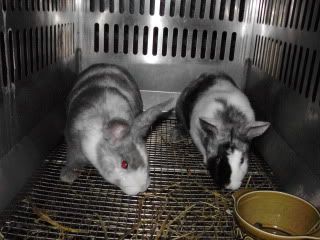
you need to start with basically healthy rabbits. Such as these two. these two came in at 5.13 and 5.01
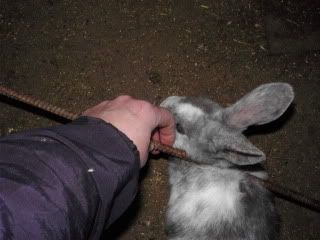
I use a piece of rebar. It's about 2 feet long. This is approximately where I put it. Most buns don't move at all. They face away from me. head flat to ground. I step on one side hard enough to keep rabbit from moving but without hurting it. Then grab the hind legs and pull up as I simultaneously step on the other side. After doing about 60 rabbits in 3 years the bar has a wee bit of a bend in it. I'm on the prowl for a new piece.
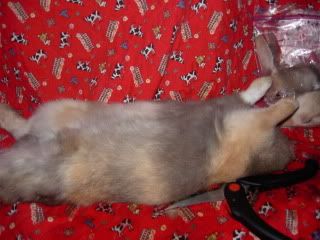
I remove head after it is dead using the poultry shears. I pull hard enough that the head is disconnected from the body so I just cut through the skin holding it together. I hold the bunny between my knees to cut off head and then I hold over bucket until blood is drained. The head gets popped into a bag for later resale... three big heads to one bag or four small. I rarely hang my dog food rabbits. I will "pee" the rabbit at this point as well. If I don't get any pee I make a mental note of that. To pee a rabbit you push down on the lower belly, sliding your thumb all the way down at least twice.
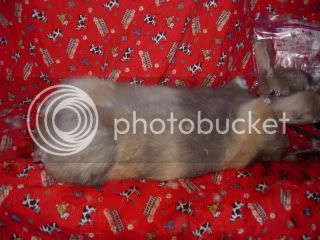
I then remove the feet. Most of the time I pop these into a large freezer bag for resale to small breed dogs as treats, today I simply didn't bother.
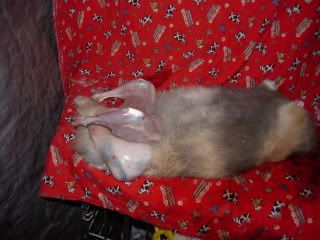
I skin differently from many as I have my bunnies lying flat. So I make a slit in the belly (between hind legs) then I pull one hind leg through at a time.
Then I lay the bunny flat and spin it around. and then slowly work off the rest of the carcass. Couldn't take pics of that as well...I was rather busy at the time! Doesn't take long usually to skin the rabbit unless it's a buck older than six months.
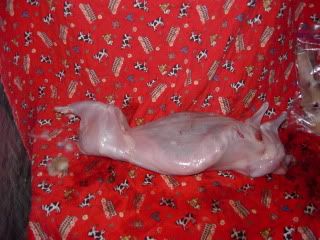
Skinned rabbit. I look it over closely to make sure that what I think is a healthy rabbit is indeed a healthy rabbit. No abscesses, no gross disfigurations, and so forth.
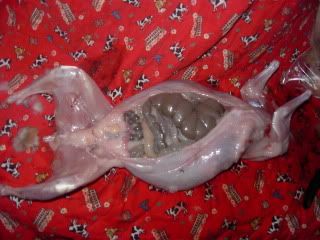
Small slit between back legs .. if a buck just in front of where the testicles are.. there is a handy little line to follow. make is a shallow cut, use your fingers to make it a bit wider and hold it open just enough to get the shears into it and just slice up! You want to open it, lay the rabbit flat and give a good look over.
If serving just a skinned rabbit only open up enough to check the liver for spots. Rinse it off and pop it into a freezer bag.
IF you customer wants the intestines separate, then these steps come next.
if you didn't succeed in "peeing" the rabbit (that where you try to empty the bladder) see if there is any urine in the bladder. if so...empty it. If not, pay more attention to the rest of the animal. A rabbit that doesn't drink has something wrong with it somewhere. Sometimes it's just because the rabbit just voided but it's a rare occurance to not have some urine in the bladder.
You want to check for normal feces in the lower part of the intestines, a soft/hard feeling tummy, no jelly poops in the intestinal tracts, no gross swelling of any part of the intestinal tract. If all looks good, take it out and bag it. ONLY remove the stomach and the intestines. Leave EVERYTHING else. If ANYTHING is off...put it into your toss bucket. These are dogs you are feeding, someone's much loved pet or business don't risk anything.
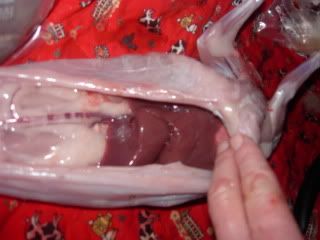
Check the liver for abnormalities (coccidia spots, yellowing, a speckly look, and such like). Check the kidneys... they should be a pinkish/purple with a faint yellow overtone.
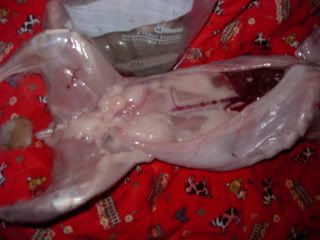
If all good, rinse the bunny and bag it.
If anything seems off, check the lungs and heart.
if they are good, bag the rabbit (after rinsing).
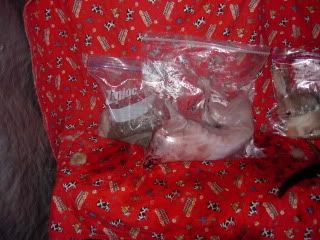
If you see lots of things wrong...toss the rabbit into your dump bucket. Don't mess with other people's pets. Just not worth it.
Label the bag with rabbits weight.
Mark the box you are shipping them in as animal grade, not for human consumption.
Graphic content!
I stress to my dog food customers that I will do what they want for rabbit prep BUT it will be a rough clean only. Random hair attached to legs will be left. I leave as much of the internal organs intact as I can. I do not remove excess fat.

you need to start with basically healthy rabbits. Such as these two. these two came in at 5.13 and 5.01

I use a piece of rebar. It's about 2 feet long. This is approximately where I put it. Most buns don't move at all. They face away from me. head flat to ground. I step on one side hard enough to keep rabbit from moving but without hurting it. Then grab the hind legs and pull up as I simultaneously step on the other side. After doing about 60 rabbits in 3 years the bar has a wee bit of a bend in it. I'm on the prowl for a new piece.

I remove head after it is dead using the poultry shears. I pull hard enough that the head is disconnected from the body so I just cut through the skin holding it together. I hold the bunny between my knees to cut off head and then I hold over bucket until blood is drained. The head gets popped into a bag for later resale... three big heads to one bag or four small. I rarely hang my dog food rabbits. I will "pee" the rabbit at this point as well. If I don't get any pee I make a mental note of that. To pee a rabbit you push down on the lower belly, sliding your thumb all the way down at least twice.

I then remove the feet. Most of the time I pop these into a large freezer bag for resale to small breed dogs as treats, today I simply didn't bother.

I skin differently from many as I have my bunnies lying flat. So I make a slit in the belly (between hind legs) then I pull one hind leg through at a time.
Then I lay the bunny flat and spin it around. and then slowly work off the rest of the carcass. Couldn't take pics of that as well...I was rather busy at the time! Doesn't take long usually to skin the rabbit unless it's a buck older than six months.

Skinned rabbit. I look it over closely to make sure that what I think is a healthy rabbit is indeed a healthy rabbit. No abscesses, no gross disfigurations, and so forth.

Small slit between back legs .. if a buck just in front of where the testicles are.. there is a handy little line to follow. make is a shallow cut, use your fingers to make it a bit wider and hold it open just enough to get the shears into it and just slice up! You want to open it, lay the rabbit flat and give a good look over.
If serving just a skinned rabbit only open up enough to check the liver for spots. Rinse it off and pop it into a freezer bag.
IF you customer wants the intestines separate, then these steps come next.
if you didn't succeed in "peeing" the rabbit (that where you try to empty the bladder) see if there is any urine in the bladder. if so...empty it. If not, pay more attention to the rest of the animal. A rabbit that doesn't drink has something wrong with it somewhere. Sometimes it's just because the rabbit just voided but it's a rare occurance to not have some urine in the bladder.
You want to check for normal feces in the lower part of the intestines, a soft/hard feeling tummy, no jelly poops in the intestinal tracts, no gross swelling of any part of the intestinal tract. If all looks good, take it out and bag it. ONLY remove the stomach and the intestines. Leave EVERYTHING else. If ANYTHING is off...put it into your toss bucket. These are dogs you are feeding, someone's much loved pet or business don't risk anything.

Check the liver for abnormalities (coccidia spots, yellowing, a speckly look, and such like). Check the kidneys... they should be a pinkish/purple with a faint yellow overtone.

If all good, rinse the bunny and bag it.
If anything seems off, check the lungs and heart.
if they are good, bag the rabbit (after rinsing).

If you see lots of things wrong...toss the rabbit into your dump bucket. Don't mess with other people's pets. Just not worth it.
Label the bag with rabbits weight.
Mark the box you are shipping them in as animal grade, not for human consumption.



